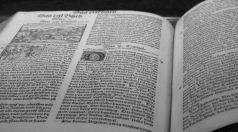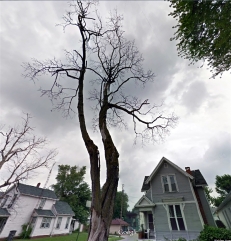You’ve probably never heard of Louis Hirschy. But if you ever lived in East Toledo or spent any time there, you likely have enjoyed the product of his passion. His works of art, if you will. For Louis Hirschy, was a sculptor, an artist of landscape and his medium was trees. Lots of them. And this mostly forgotten Swiss immigrant who arrived in Toledo in the latter part of the 19th century, is credited with planting a forest of trees in East Toledo. Thousands of trees that helped to create an urban woodland on the east side of the river. These giants of Maple, and Oak and Elm and Sycamore were planted one by one, year and after year with Hirschy’s hand guiding each root stock into the earth with a love of nature that was deep and reverent. Today, more than a century later, many of those trees, or their offspring, still live today and tower above the streets as living legacy to this “Man of Trees.”
So who was Louis Hirschy and why did he do this? According to the research I’ve been able to pull together, Hirschy came to the United States from Switzerland at an early age in about 1875, and after living in eastern Indiana, where he worked at various jobs and attended college at Valparaiso University, he and his wife Louise, eventually found their way to Toledo, settling into a wooden two-story home at 503 5th Street near Greenwood in East Toledo. Hirschy, despite his academic training and background, worked a number of years at the Toledo News Bee selling subscriptions and later, worked the rest of his life at the Toledo Shipyards on Front street as a laborer.
It now seems an odd career choice for a man like Louis Hirschy who was as enamored with books and literature as we was with trees and nature. In his 1936 obituary in the Toledo News Bee, he was called a “student of world literature” and was surrounded by a 1000 books in the study of his home where he was found dead by his two sons at the age of 78.
One of those books, was a cherished and rare Zurich Bible, printed in 1531, which he obtained while selling bibles in Indiana during his youth., gladly trading one of his new bibles for the early German language Zurich Bible, which Hirschy recognized as rare. He was correct of course, the Zurich Bible was the first printed Bible in recorded history. It is a rare and precious example of early printing that is now in the Toledo Public Library’s Rare Books collection and can be viewed upon request. It is the oldest printed book in the
collection and may well be one of the oldest Bibles in the United States. There are even some handwritten notes in it, from Hirschy about the bible’s contents and the scores of stunning and rare block wood cut illustrations from artist Hans Holbein.
Ironically, while he was a religious man, Hirschy was also appeared to be a student of evolutionist Charles Darwin. I have found that this East Toledo shipyard worker published several scholarly articles in 1902 in defense of Darwin’s controversial writings and theories.
So perhaps, it is not surprising that Hirschy also embraced a love of trees and nature that went far beyond a casual hobby. An article published in the News Bee in 1923, called Hirschy, East Toledo’s “Man of Trees”, and praised his passions for tree planting like this:
“To Hirschy, trees are a religion. They are his friends and his companions. Almost it seems
they talk to him of their troubles and they answer to his care by growing straight and tall.”
If you walk the neighborhoods around Hirschy’s old house along Greenwood Street, you can still see many of those old trees, now thick and tall and gnarled with age. Planted as saplings by Hirschy himself. Also still standing, is Hirschy’s home, which also is not much more than a remnant of a distant past. Gone are the flowers and shrubs and the small “Garden of Eden” that he planted on the property. It was in this verdant paradise he created, that Hirschy was said to have frequently relaxed with a good book to read. Today, his sanctuary of nature, is gone. But for a few ancient old vines twisted around a fence, the only other vestige I could find of his private bower of greenery was the stump of an old sycamore that he once planted. and took great pride in. So proud of this towering tree, that he made his complaint heard at Toledo city hall after overhead linemen, cut away large sections of its upper branches in 1923. To Hirschy, this was nothing less than an act of desecration and sacrilege. The axes of the workers had ruined the symmetry of the giant branches aloft and the normally even-tempered tree man let the Mayor know of his disgust for what the workers had done. That towering sycamore, by the way, survived its maiming and lived into this century. It was still visible in the photo of the house from the county auditor’s office a just a few years ago. Today, however, it is gone. Now, just rotting old stump of a tree between the sidewalk and street, shorn off by the teeth of a chainsaw blade.
Sadly, in a few years, most of the trees that this ardent arborist planted in East Toledo will also fall victim to the same fate. These, the last of the big trees that formed a perennial summer canopy of shade for decades over this area of town. There is one thing, however, that he did plant that will likely live longer than the trees. Not a tree, not a shrub, not a flower, but a “seed” harvested from the arbor of literature. That being the name of the street where he lived. For, when Hirschy moved to the neighborhood in 1894, it was still a rural crossroads and Walden Street was called Fifth Street. But, because of his appreciation for the writings of Henry David Thoreau about Walden’s Pond, Louis Hirschy along with other neighbors, went to Toledo City Council in 1905, and requested the name of his street be changed from Fifth Street to “Walden Street”. Council approved the idea. From then on, 503 Walden Street is where Hirschy called home, and lived out the balance of his abundant life. Specifically, at the corner of Walden and Greenwood, a fitting name and place for Toledo’s “Man of Trees”.
Discover more from THE TOLEDO GAZETTE
Subscribe to get the latest posts to your email.





I am wondering who the author of this piece is? Louis Hirschy was my great grandfather. My mother, Mary Louise Hirschy Kuhlman, who grew up knowing Louis, her grandfather, became a literature teacher at Eastwood High School in Pemberville, Ohio. Mary, is now 86 years old, living near Pemberville. Mary has some of Louis’s books and she was head of the book club in Pemberville, called Portage River Readers, for many years until 2015.
Katherine,
Thanks for contacting me. I am the author of the article and even produced a video story about Louis for WDHO TV a few years ago.How esxciting to know that his family still lives in the area. I was always impressed with his story and whenever I drive through East Toledo I look up at the trees and think about him.
So Genoa Kid is Lou Hebert? This was a great article and I posted it on my Facebook page receiving many nice comments. How might I obtain or purchase several copies (video DVD) of the news story you did for WNWO TV in 2011? I would like to have one for myself and also share a copy with my mother. Is the news story on YouTube?
Katherine,
Thanks for contacting me. I was always impressed with Louis’s story and even produced a TV news story about him for WNWO TV in 2011. It sounds like you and your mother probably have other wonderful stories to share about his remarkable talents and legacy. Feel free to get in touch anytime so we could talk more.
Regards,
Lou